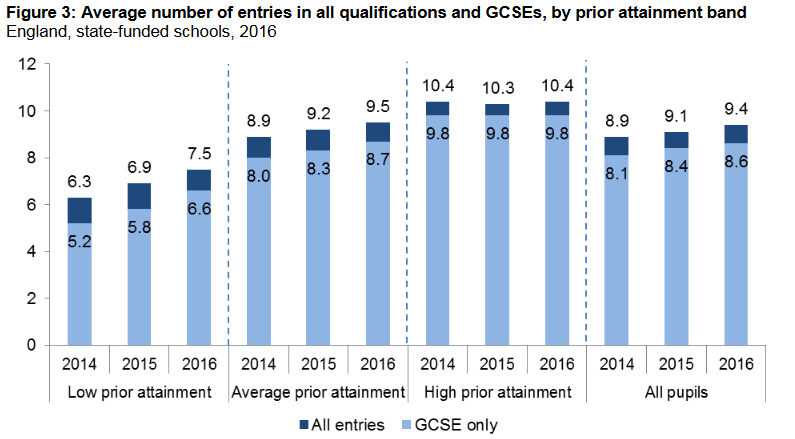The government has released provisional key stage 4 data this morning that reveals how schools have fared in new headline accountability measures.
The data includes figures on the new Progress and Attainment 8 measures (our analysis here) and also provides an update on EBacc figures. Here we round up the key findings from the EBacc data.
1. Slightly more pupils are entering the EBacc, but the government is still WAY off its 90 per cent target
Provisional figures show the percentage of pupils entering the EBacc rose from 38.6 per cent in 2015, to 39.6 per cent this year. While it is a rise (the figure actually dropped from 2014 to 2015) the government is still way off reaching its 90 per cent target.

2. But greater numbers of pupils are entering more EBacc subjects
The percentage of pupils entering four out of the five EBacc components rocketed from 26.7 per cent to 37.5 per cent, with fewer pupils taking two or three EBacc subjects.

3. More state school pupils are now achieving the EBacc – but the rise isn’t wholly down to better results
A total of 24.5 per cent of pupils in state-funded schools achieved the EBacc, an increase of 0.6 percentage points. But this rise is split between an actual rise in results, and a tweak in measuring them.

4. More pupils with low prior attainment are taking the EBacc, which is driving up Attainment 8 results
The data shows that schools are, unsurprising, adapting their curricula to match the new headline measures. Pupils in state-funded schools filled an average of 2.7 EBacc slots (counted in the Attainment 8 measure) this year, compared to 2.4 this year.
The report said the increase was “particularly marked” for pupils with low prior attainment (up from 1.3 to 1.9), adding: “This suggests some of the increase in the attainment 8 score is driven by schools’ behaviour change as pupils enter more qualification that count towards the new measures.”
Additional analysis by Education Datalab claims these figures show that the introduction of Progress 8 as an accountability measure is actually driving curriculum change more than the EBacc is.

5. Pupils are also entering more qualifications, and more of them are GCSEs
Again, pupils with low prior attainment show the biggest increases. GCSEs made up 83 per cent of all entries for these pupils in 2014, increasing to 88 per cent this year.
There was no change for pupils with high prior attainment, at 94 per cent.

6. Bye bye BTEC science
Entry number for EBacc English and maths remained stable (they are compulsory so most pupils enter each year) but pupils taking two sciences shot up by 12.4 percentage points, to 86.7 per cent (for state schools).
The report states this increase is driven by pupils with lower prior attainment moving from science BTECs to core and additional science.

Additional analysis of the figures by Education Datalab found that much of the GCSE take-up was in local authorities that previously had lower entry rates.
They found under 40 per cent of pupils entered two sciences, in 2011, in Halton, Knowsley, City of Hull, north-east Lincolnshire and Stoke-on-Trent.
This year that figure was more than 75 per cent in each of the areas – meaning there is now “less regional variation in entry rates” in GCSE sciences.
7. But entry to languages and art and design subjects is falling
Entries to EBacc languages fell by 0.3 percentage points to 49 per cent this year. Datalab states the stall in language entries is also impacting the EBacc entry rate. It follows concerns there aren’t enough language teachers needed for the EBacc to work.
Analysis by the National Association of Headteachers also found that 77.7 per cent of pupils who entered four out of the five EBacc components were missing the languages component in 2016 (up from 67.4% in 2015).
The number of pupils entering at least one arts subject also decreased, by 1.7 percentage points down to 47.9 per cent this year.








Your thoughts